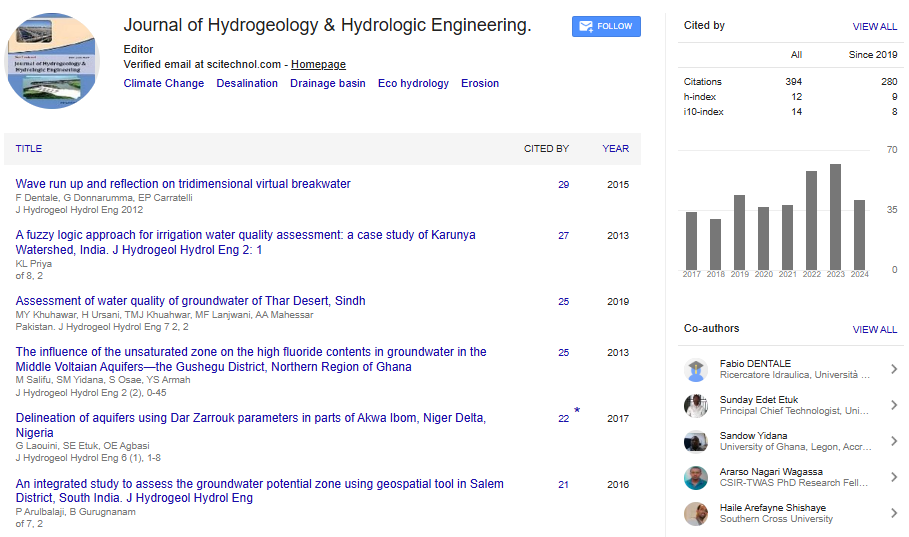Commentary, J Hydrogeol Hydrol Eng Vol: 13 Issue: 4
Vadose Zone Hydrology: A Key Element of Groundwater Management
Louis Rooy*
1Department of Geology, University of Pretoria, Pretoria, South Africa
*Corresponding Author: Louis Rooy,
Department of Geology, University of
Pretoria, Pretoria, South Africa
E-mail: rooyl574@gmail.com
Received date: 29 July, 2024, Manuscript No. JHHE-24-149246;
Editor assigned date: 31 July, 2024, PreQC No. JHHE-24-149246 (PQ);
Reviewed date: 14 August, 2024, QC No. JHHE-24-149246;
Revised date: 21 August, 2024, Manuscript No. JHHE-24-149246 (R);
Published date: 29 August, 2024, DOI: 10.4172/2325-9647.1000334
Citation: Rooy L (2024) Vadose Zone Hydrology: A Key Element of Groundwater Management. J Hydrogeol Hydrol Eng 13:4.
Description
Vadose zone hydrology focuses on the unsaturated area between the earth's surface and the groundwater table. This zone, also known as the unsaturated zone, plays an essential role in the movement of water, gases and nutrients and acts as a buffer between surface water and groundwater. Vadose zone hydrology is significant in various environmental and engineering fields, particularly in the management of water resources, pollution control and agricultural practices.
The vadose zone is characterized by a mixture of air and water in the soil pores, unlike the saturated zone below, where pores are entirely filled with water. Water movement in this zone is primarily governed by capillary forces and gravity. In addition to water, gases like oxygen and carbon dioxide move through the vadose zone, affecting microbial processes and chemical reactions that take place there.
The thickness of the vadose zone can vary from just a few centimeters to several meters, depending on local geography and climate. In arid regions, for example, the vadose zone may be several meters thick, whereas in wetter regions, it could be thin or even absent.
Water enters the vadose zone primarily through precipitation or irrigation. Once in the soil, water moves vertically or horizontally based on the properties of the soil and the forces acting on it. The movement of water in the vadose zone can be divided into two main categories.
This process occurs when water enters the soil surface and percolates down through the unsaturated zone. The infiltration rate depends on the soil type, vegetation cover and the amount of water being applied. As water moves deeper into the soil, it eventually reaches the groundwater table, where it becomes part of the saturated zone. Percolation rates are influenced by the permeability of the soil, which determines how quickly water can pass through it. Understanding these processes is essential for predicting groundwater recharge, especially in areas where water resources are scarce.
Vadose zone hydrology is particularly important in agriculture, where efficient water management is essential for crop production. Farmers need to understand how water moves through the soil to ensure that crops receive the right amount of moisture while minimizing water waste. Too much water can lead to leaching of nutrients from the soil, whereas too little water can result in drought stress for crops.
Modern irrigation techniques, such as drip irrigation, are designed with vadose zone dynamics in mind. These systems aim to apply water directly to the root zone of plants, minimizing water loss through evaporation and deep percolation.
Another precarious aspect of vadose zone hydrology is its role in the transport of pollutants. When contaminants such as pesticides, fertilizers, or industrial chemicals are introduced at the surface, they can infiltrate into the vadose zone. Understanding how these substances move through the unsaturated zone is key to moderating groundwater contamination.
In some cases, pollutants may be adsorbed by soil particles or degraded by microorganisms in the vadose zone, reducing the risk of contamination. However, if the soil has low adsorption capacity or the contaminant is highly mobile, there is a greater chance that it will reach the groundwater, posing a risk to water supplies.
Vadose zone hydrology also has applications in environmental engineering, particularly in the design of systems for managing stormwater runoff, wastewater treatment and landfill leachate control. Engineers must account for how water and contaminants move through the vadose zone to prevent environmental damage and protect public health.
For example, in the design of septic systems, the movement of wastewater through the vadose zone is carefully managed to ensure that contaminants are treated before reaching the groundwater. Similarly, stormwater management systems are designed to promote infiltration and reduce surface runoff, preventing flooding and soil erosion.
Conclusion
Vadose zone hydrology plays a vital role in water resource management, agriculture, pollution control and environmental engineering. By understanding how water and contaminants move through the unsaturated zone, we can make informed decisions that protect groundwater quality, enhance agricultural productivity and prevent environmental degradation. As climate change and population growth increase pressure on water resources, the importance of vadose zone hydrology will continue to grow in the years ahead.
 Spanish
Spanish  Chinese
Chinese  Russian
Russian  German
German  French
French  Japanese
Japanese  Portuguese
Portuguese  Hindi
Hindi 
